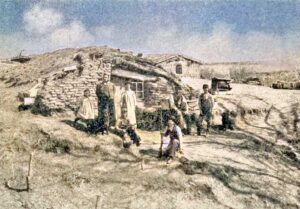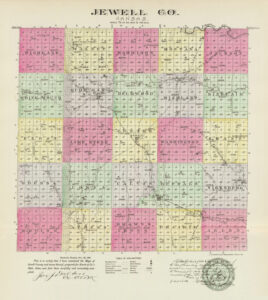Early in May 1869, a colony of Scotch mechanics from Brooklyn, New York, relocated in far western Jewell County. Lewis A. Walker was president, and A. Macdonald was secretary.
This group of 200 families, composed of farmers and mechanics of various trades, intended to found a town to operate various factories. The members selected claims on White Rock Creek, between Burr Oak and Johns Creek. At that time, this section was on the frontier, and for protection against the hostile Indians, the settlers erected a blockhouse about two miles east of Holmwood. On May 25, some of the settlers and colonists petitioned Governor James M. Harvey for protection against the Indians, who they reported had killed and scalped about 20 settlers. Arms, ammunition, and authority to raise militia companies were requested. However, relief did not come promptly as the situation demanded, so the colonists abandoned their location. Some of them, while moving to a place of safety, were attacked by Indians and robbed of all their possessions but succeeded in escaping alive.
During the summer, the company underwent a reorganization, later known as the Excelsior Cooperative Colony of Kansas. John F. McClimont was president, Henry Evans was vice president, and Hugh McGregor was secretary. At a meeting held in New York on October 2, 1869, John F. McClimont, Hugh McGregor, and Alex White, Jr., were appointed to a locating committee and soon set out for Kansas again. Within 40 days, they again communicated with Governor Harvey on November 12, 1869, stating they wished to settle in Republic County. Arriving in December 1870, they were poor, and the first money they earned was turned into a common treasury, the proceeds of which were used to purchase a yoke of oxen to haul stone to build a colony house. After this was erected, the members occupied it until the spring of 1871, when they separated to work at their trades and develop their claims, soon becoming some of the most well-to-do citizens of the state.
©Kathy Alexander/Legends of Kansas, November 2024.
Also See:


